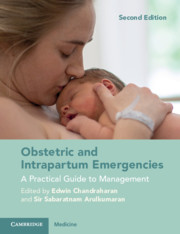Book contents
- Obstetric and Intrapartum Emergencies
- Obstetric and Intrapartum Emergencies
- Copyright page
- Contents
- Contributors
- Preface
- Preface to the First Edition
- Acknowledgements
- Section 1 General Principles
- Section 2 Algorithms for Management of the Top Five ‘Direct Killers’
- Section 3 Intrapartum Emergencies
- Chapter 8 Uterine Rupture
- Chapter 9 Breech Delivery
- Chapter 10 Umbilical Cord Prolapse
- Chapter 11 Fetal Compromise
- Chapter 12 Shoulder Dystocia
- Chapter 13 Twin Delivery
- Chapter 14 Instrumental Vaginal Delivery
- Chapter 15 ‘Crash’ Caesarean Section
- Chapter 16 Unintended Trauma and Complications During Caesarean Section
- Chapter 17 Obstetric Emergencies in Midwife-Led Settings
- Section 4 Postpartum Emergencies
- Section 5 Medical and Surgical Emergencies During Pregnancy
- Section 6 Anaesthetic Emergencies During Pregnancy
- Section 7 Neonatal Emergencies and the Management of Immediate Neonatal Problems
- Section 8 Management of Anticipated and Non-anticipated Emergencies in Pregnancy
- Section 9 Setting-Up Skills and Drills Training in Maternity Services and Reducing Avoidable Harm
- Index
- References
Chapter 17 - Obstetric Emergencies in Midwife-Led Settings
from Section 3 - Intrapartum Emergencies
Published online by Cambridge University Press: 06 May 2021
- Obstetric and Intrapartum Emergencies
- Obstetric and Intrapartum Emergencies
- Copyright page
- Contents
- Contributors
- Preface
- Preface to the First Edition
- Acknowledgements
- Section 1 General Principles
- Section 2 Algorithms for Management of the Top Five ‘Direct Killers’
- Section 3 Intrapartum Emergencies
- Chapter 8 Uterine Rupture
- Chapter 9 Breech Delivery
- Chapter 10 Umbilical Cord Prolapse
- Chapter 11 Fetal Compromise
- Chapter 12 Shoulder Dystocia
- Chapter 13 Twin Delivery
- Chapter 14 Instrumental Vaginal Delivery
- Chapter 15 ‘Crash’ Caesarean Section
- Chapter 16 Unintended Trauma and Complications During Caesarean Section
- Chapter 17 Obstetric Emergencies in Midwife-Led Settings
- Section 4 Postpartum Emergencies
- Section 5 Medical and Surgical Emergencies During Pregnancy
- Section 6 Anaesthetic Emergencies During Pregnancy
- Section 7 Neonatal Emergencies and the Management of Immediate Neonatal Problems
- Section 8 Management of Anticipated and Non-anticipated Emergencies in Pregnancy
- Section 9 Setting-Up Skills and Drills Training in Maternity Services and Reducing Avoidable Harm
- Index
- References
Summary
An increasing number of parents are choosing to give birth in midwife-led settings such as alongside midwifery units and freestanding midwifery units [1]. These are midwife-led facilities which may be on the same premises as an obstetric unit (alongside [AMU]) or away from an obstetric unit on its own premises (freestanding [FMU]). The National Institute for Health and Care Excellence (NICE) [2] published guidance for healthcare professionals and parents on the safety of birthing in these units. Evidence has found that it is safer for primiparous women to give birth in either an AMU or an FMU and for multiparous women to give birth at home [3, 4]. This is because women are less likely to need intervention such as the use of forceps or epidural for analgesia than if they give birth in obstetric-led facilities. With the introduction of a government-supported paper, ‘Better Births’ [5], more emphasis is being put on information and education for parents on birthing in community-based settings to increase home birth rates and the care given in the community (Figure 17.1).
- Type
- Chapter
- Information
- Obstetric and Intrapartum EmergenciesA Practical Guide to Management, pp. 120 - 132Publisher: Cambridge University PressPrint publication year: 2021

